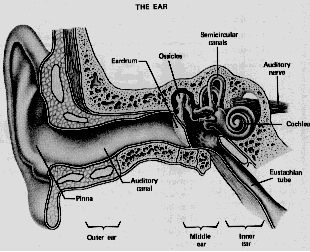
Introduction
The physiology of our hearing mechanism can conveniently be divided into three topics:
1 The outer ear (auricle or pinna) and ear canal
2 The middle ear
3 The inner ear
The Auricle and Ear Canal.
Each hole in the side of the skull leads into an ear canal. The ear canal is an irregular
cylinder with an average diameter of less than 0.8 mm and about 2.5 cm long.
The ear canal (figure 1) is open at the outer end which is surrounded by the pinna (or auricle). The pinna plays an important spacial focusing role in hearing. The canal then narrows slightly and widens towards its inner end, which is sealed off by the eardrum.
Thus the canal is a shaped tube enclosing a resonating column of air - with the combination of open and closed ends. This makes it rather like an organ pipe.

THE EAR CANAL. [Rigden, 1960]
The ear canal supports (resonates or enhances) sound vibrations best at the frequencies which the human ears hear most sharply. This resonance amplifies the variations of air pressure that make up sound waves, placing a peak pressure directly at the eardrum.
For frequencies between approximately 2 KHz and 5.5 KHz, the sound pressure level at the eardrum is approximately 10 times the pressure of the sound at the auricle.
The Eardrum - interface between outer and middle ear.
Airborne sound waves reach only as far as the eardrum. Here they are converted into
mechanical vibrations in the solid materials of the middle ear.
Sounds (air pressure waves) first set up sympathetic vibrations in the taunt membrane of the eardrum, just as they do in the diaphragm of some types of microphone. The eardrum passes these vibrations on to the middle ear structure.